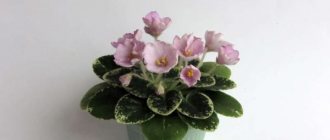Among fans of indoor plants, violet is very loved and popular due to its beauty. This flower is also called Saintpaulia, viola, moth and pansy. Biologists count more than 500 varieties of violets, and some believe that there are already more than 1000, each of which is charming and unique in its own way. One of these varieties is “Cinderella’s Dream”.
Dear readers! For you, we have created communities on social networks in which useful articles and interesting ideas are published several times a day! Subscribe and receive useful content in a convenient format!
This flower differs from its fellows in its petals and leaves, and in its unusual flowering form. It is these differences that make it possible to distinguish this variety of viola into a separate variety.
Flowers
The beautiful appearance of the violet is created by its flowers.
The flowers of this variety are delicately white in color with a lilac edge.
Coloring occurs some time after dissolution. Initially, young flowers are pure white.
Flowers reach a size of up to 4 centimeters.
“Cinderella’s Dream” blooms early, although the flowers often fall off, but flowering begins again immediately. "Cinderella's Dream" has up to 6 buds on one peduncle.
The structure of the flower is also interesting: a corrugated shape with voluminous ruffles.
Reviews
Natalia. “The opinion of some flower growers about violets in general is interesting. Especially regarding terry types, they are the best. I strongly disagree with this. “Cinderella’s Dream” is such a beautiful and wonderful violet, which also does not require special care or conditions. I have been propagating it beautifully for several years now. I have put together a wonderful collection of different shades. And what kind of abundant and harmonious flowering does it have? All the flowers are one to one, with fringe, translucent under the light of the lamp. Wonderful variety."
Many gardeners are attracted by the color of the variety.
Anastasia. “A neat, beautiful, romantic, fairy-tale-like variety. I bought it at a flower show a couple of years ago and am not at all happy with it. The corrugated flowers are so delicate and numerous that they create coziness in the house for a very long time in the form of a huge hat.”
Marina Dyagileva. “For many years I have been trying to grow Cinderella’s Dream, but I just can’t create the conditions in my essentially cool house. I tried to grow it several times, but when I acquire babies, I just can’t get them to bloom. What am I doing wrong? Or are the conditions in the house not allowing you to achieve a positive result? But I still try all the time.”
Photo of violet “Cinderella’s Dream”
Growing conditions
This variety of Saintpaulia is unpretentious, however, some growing rules will allow you to achieve long flowering and rapid growth.
Find out about other varieties on the site: violet “Blue Dragon”, violet “Blue Fog”, violet “Esmeralda”, violet “Lituanica”, violet “Ice Rose”, violet “Olesya”, violet “Summer Twilight”, violet “Chanson” , violet "Jan Minuet" and others
Priming
The soil for the “Cinderella's Dream” variety of violets, like any other variety of indoor violets, is no different from outdoor flowers.
Violets love nutritious loose soil. The main condition for favorable flower growth is breathable and moisture-absorbing soil.
If you decide to prepare the soil for Saintpaulias yourself, forest soil would be the ideal option.
Turf, rotted leaves, sphagnum moss and sand are components of suitable soil for violets.
For older flowers, the soil must be rich in nutrients to ensure lush flowering and flower growth. During this period, soil replenishment will be necessary.
In specialized flower shops you can purchase ready-made universal soil. The advantage of such a substrate is its absolute biological sterility. The finished soil can be improved by adding sphagnum moss or perlite. There must be expanded clay drainage at the bottom of the pot.
Choosing a pot for violets
Since the roots of Saintpaulia grow not deep, but to the side, a shallow pot is needed.
In addition, violet roots need a lot of air and light and ventilation. Ideal sizes for Cinderella's Dream:
- 9x9 cm – for adult Saintpaulias;
- 7x7 cm – for medium-sized flowers;
- 5x5 cm - for baby violets.
Lighting
Since the birthplace of Saintpaulia is North Africa, and in these places the lengths of day and night are the same, the approximate time of necessary lighting for flowers is 12-14 hours.
Violets love light, but direct sunlight is not suitable for them. Therefore, it is better to place flower pots on the north, east and west sides. The place where the flower is located should be well lit.
Important! In winter, due to the decrease in daylight hours, flowers need artificial lighting.
Required temperature and humidity
As for temperature, violets do not tolerate cold and drafts; they also do not like heat with high humidity.
Rare temperature changes are also undesirable. grow very well and bloom magnificently at a temperature of 20-22 degrees.
As a tropical plant, violet needs moisture, and the optimum temperature must be maintained. You cannot spray the leaves, but you can spray water in the air near the flowers. You can also place saucers or cups of water near flower pots.
Features of flowering, growth and reproduction
How does it develop at home?
Growth and development at home is quite normal, subject to the usual and simple rules of care .
A sufficient amount of lighting, temperature, proper watering - these are all the requirements for the plant to develop successfully and delight the grower with harmonious flowering.
According to experienced violet growers, this variety is unpretentious and absolutely not difficult to grow.
How long does it take to grow an adult plant?
Approximate time of plant formation when propagated by leaves:
- It takes about a month for the roots to emerge from the leaf;
- It takes 1-1.5 months for babies to appear;
- Up to 3 months before the phase of separation of the children from the mother plant;
- Up to 9 months for the first flowering of a young plant.
This variety grows in 1.5-2 years.
It must be taken into account that the first flowering is not full . On average, it takes from 1.5 to 2 years for a violet to “mature”, with proper care.
Reproduction methods
“Cinderella’s Dream” can be propagated vegetatively:
- Rooting the leaf;
- Or stepchildren.
Rooting with leaf cuttings
A completely healthy leaf, free of flaws and spots, occupying the 2nd row of the rosette , is cut off and placed petially in a container with warm and clean water.
When roots up to 1.5 cm in size appear on it, it is transplanted into a glass containing a composition of soil and sand in a ratio of 1 to 1.
It is in this container that the leaf takes root before the first babies appear - about a month.
Important! When the children develop leaves with a diameter of about 3 cm, they are separated and transplanted into separate containers.
Rooting by stepsons
The stepchildren are disconnected from the mother plant using tweezers or an awl , and then planted in a sand-soil mixture. Moreover, each of the stepsons must have 3 or 4 full-fledged leaves and roots.
Important! Reproduction by stepsons practically preserves the varietal characteristics of the parent. Moreover, such a plant blooms earlier than when the leaf is rooted
.
Sometimes you can take a stepson to propagate violets.
Flowering options
flowering variations for collectors
- A white flower with a mesh and strawberry-colored ruffle on the two upper petals;
- A white flower with a mesh and strawberry-colored ruffle on all petals;
- And the most striking option, memorable for its variably white flowers with strawberry ruffle and mesh on all petals.
The greenish tint of the fringe appears when the growing temperature is below optimal.
Attention! It is this variability that is of particular value and uniqueness for collectors.
Standard flower size, number of buds on a peduncle
The size of the flowers is not considered very large. Average size is about 4 cm . There are usually about 6 buds on a peduncle, but there are many peduncles, so the flowering plant looks like it has cap blooms.
According to some gardeners, the flower stalks are too long, which does not look very aesthetically pleasing. But the length of the peduncle depends on the amount of lighting.
With enough light, the peduncles are of normal length, standard for violets.
Is it possible to achieve cap flowering?
Bouquet flowering is almost constant . The first flowering begins with 2-3 peduncles, but after 2-3 flowerings a cap flowering appears and forms.
Bud lifespan
If the temperature is not hot and there is sufficient nutrition, flowering lasts about a month . Frequent flowering, with a large number of peduncles, is one of the advantages of the variety.
One flower can bloom for up to 9 days.
Of the minor shortcomings, you can o . But there are not so many of them, and they stay on the peduncle for quite a long time (up to 7-9 days). This usually does not prevent cap flowering.
Effect of lack of lighting
A sufficient amount of daylight is half the success when growing violets at home. Violet leaves are adapted in such a way that they catch a certain spectrum of light, which has a significant impact on the synthesis of organic substances in the plant.
Lack of lighting causes:
- Slow growth;
- Premature drying of buds;
- And not forming new ones.
The flower stalks will stretch towards the light and turn out to be quite long and spreading, which will significantly spoil the picture of the cap flowering.
Effect of cool temperature
A slightly lower than optimal temperature during the flowering period ensures its duration. You can also notice at this temperature the appearance of fringe with a greenish tint on the petals.
Watering
Watering is one of the main actions that contribute to the life of sempolia.
Despite the fact that the violet is a moisture-loving flower, too much water will destroy it. But excessive dryness will also harm the plant.
It should be watered no more than twice a week. Moreover, water should not get on the leaves and flowers. The best option for watering is to ensure that there is always water in the trays of the pots. Thus, the plant will receive a sufficient amount of moisture, not water.
Transplanting a plant
Over time, when the soil loses all its nutrients and the root system of the plant grows, the violet needs to be replanted.
It is very easy to determine this time: a white coating appears on the surface of the soil in the pot, which means that the soil is oversaturated with mineral fertilizers and has poor air permeability.
It is better to replant Saintpaulia in the warm season with fairly good lighting. The flowering period of violets is unfavorable for transplanting them, so it is better to wait until they bloom.
Having thoroughly cleaned the violet's root system of rotten and old roots, the plant is transplanted into a clean pot with new soil. There is no need to water the newly planted flower; you can cover it with a plastic bag.
Photos and detailed description of the variety
Violet Cinderella's dream - the creation of breeder A. Deikun. The main advantage of the variety is flowers of interesting shapes with original colors. The corrugated petals of the upper part of the flower are decorated with a rich mesh of lilac-strawberry color. During bloom, the flower is completely white, and only over time does color begin to appear on the petals.
[adsp-pro-4]
Collectors of violets present several color options in the descriptions of the variety:
- white with a strawberry-colored mesh on the two upper petals;
- white with mesh on the upper ones and ruffles of a brownish-strawberry hue on all petals;
- white with a strawberry-colored ruffle on the upper ones and a mesh of variable colors on all petals.
This variability in color makes the photo and description of each violet specimen presented online almost unique. Some gardeners note that in cooler conditions, even flowers with green fringe on the petals bloom.
The diameter of the Cinderella's Dream violet flowers is about 4 centimeters. Violet blooms often, with 5-6 buds formed on each peduncle. The total flowering duration is 30-40 days.
The rosette of the variety is standard, slightly spreading, forms independently and does not outgrow. The leaves are wavy, dark green, large. The surface of the leaf is shiny. The reverse side of the leaf is reddish or deep red, depending on the lighting conditions in which the plant is kept.
Fertilizer and feeding
As for additional nutrition, violet especially urgently needs feeding in spring and autumn. At least once a month, the flower must be fed with mineral fertilizers. Nitrogen, potassium and phosphorus are necessary elements that promote favorable growth and lush flowering of violets. You can fertilize in the same way as watering - through a tray.
Important!
- do not feed young plants up to two months old;
- plants that are sick or affected by pests are not fertilized;
- Do not apply fertilizers in conditions of high humidity and direct sunlight.
Choosing soil and pot for viola
The soil for indoor violets differs little from garden violas. Like their “street brothers,” domestic Saintpaulias love nutritious and loose soil. The ideal composition is sand (1 part), peat (3 parts) and black soil (5 parts). For additional nutrition, you can add sphagnum moss or a little charcoal to the soil.
The pot for the Cinderella's Dream violet should not be deep; a low container with a diameter of 7-10 cm will suffice. In a smaller pot, the plant will be cramped.
Diseases and pests
Like all indoor plants, Saintpaulias are susceptible to some diseases.
There is also a threat in the form of some parasites that can destroy the root system, flowers and leaves.
Mites, stink bugs, aphids, flies, woodlice, whiteflies, coccids are some of the parasitic insects that can be deadly to violets.
Parasites can be controlled by treating plant leaves or soil with pesticides.
Diseases that can affect the Cinderella's Dream plant:
- Fusarium - sudden changes in temperature, cold water when watering contribute to rotting of the roots;
- powdery mildew - a white coating that appears on violet leaves as a result of low temperature and too high humidity;
- late blight - lack of light and excess moisture make the leaves lethargic and lifeless;
- gray rot - leaves rot due to water getting on them.
All diseases can be prevented and cured. At the early stage of diseases, it is enough to tear off all rotting and diseased leaves and provide the plant with proper care. If the disease is already advanced, then the plant must be treated with pesticides.
Reproduction methods
According to reviews from flower growers, the Zolushkin Dream variety is easily propagated by vegetative methods:
- Rooting a leaf cutting. A healthy leaf, without damage or stains, is cut from the second row of the rosette and placed suspended in a glass of water. After roots 1-1.5 centimeters long appear on the cuttings, the leaf is planted in a cup with sand and soil (1:1). The leaf can be immediately rooted in the soil mixture. After about 4 weeks, babies grow on the cuttings. As soon as the diameter of the leaves of the children reaches 3 centimeters, they are separated and planted in separate pots.
- Rooting of stepchildren. This method of propagation makes it possible to preserve all the varietal characteristics of the mother plant and obtain earlier flowering than when propagated by leaf cuttings. The stepchildren are separated from the mother plant with an awl or tweezers and planted in pots with a sand-soil mixture. Each stepson should have 3-4 full leaves and roots.
The easiest way to propagate violets is to root a healthy leaf.











